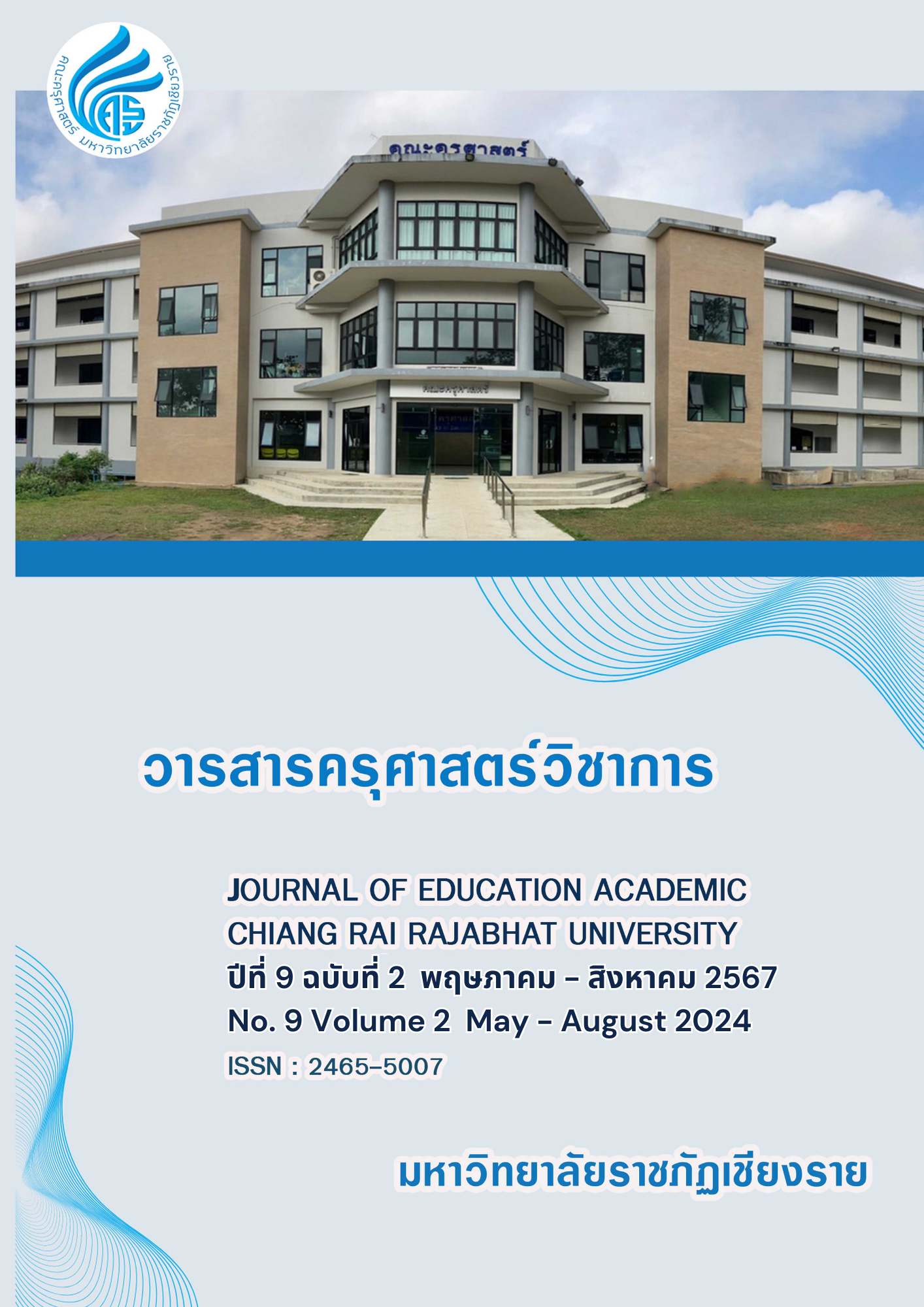The Components of Competency for Educational Institution Administrators of Triam Udom Suksa Pattanakarn Affiliated Schools
Keywords:
The Components of Competency, Educational Institution Administrators, Triam Udom Suksa Pattanakarn Affiliated SchoolsAbstract
This research aimed to 1) investigate the competency for educational institution administrators of
Triam Udom Suksa Pattanakarn affiliated schools, 2) explore actual and desirable conditions of the competency for educational institution administrators of Triam Udom Suksa Pattanakarn affiliated schools, and 3) construct and assess of the competency for educational institution administrators of Triam Udom Suksa Pattanakarn affiliated schools. This research is a survey research type. A sample group of 334 people who were teachers of 19 schools in the Triam Udom Suksa Pattanakarn group. The tools used by the researcher in this research. It is a questionnaire regarding the competency components of educational institution administrators at Triam Udom Suksa Pattanakarn Schools, divided into 2 parts as follows: Part 1: Basic information of the respondents, including gender, age, educational level. Current position and work experience There is a multiple choice format with answers given. Part 2: Current conditions and desired conditions of competencies of educational administrators of schools in the Triam Udom Suksa Pattanakarn group. It is a 5-level rating scale questionnaire and an assessment form of competency of educational institution administrators at Triam Udom Suksa Pattanakarn affiliated schools. To analyze the data, the researcher conducted statistics consisting of percentage, mean, standard deviation, and Priority Needs Index (PNI). The findings revealed that 1) the competency for educational institution administrators of Triam Udom Suksa Pattanakarn affiliated schools included 3 factors: 1.1) Knowledge, 1.2) Skill, and 1.3) Trait. 2) The overall actual conditions of the competency for educational institution administrators of Triam Udom Suksa Pattanakarn affiliated schools showed a high level. Meanwhile, the overall desirable conditions of the competency for educational institution administrators of Triam Udom Suksa Pattanakarn affiliated schools indicated the highest level. 3) The constructed model was found to have four major parts, as follows: Part 1: principles and objectives; Part 2: competency components; Part 3: the competency development process consisting of five steps: Step 1: preparation for development; Step 2: development necessity; Step 3: development operations; Step 4: implementation; Step 5: development evaluation; and Part 4: evaluation of operations and success conditions. The results of evaluating the appropriateness of the model and the feasibility of the model were found to be at the highest level.
References
กระทรวงศึกษาธิการ. (2546). พระราชบัญญัติการศึกษาแห่งชาติ พ.ศ. 2542 และแก้ไขเพิ่มเติม (ฉบับที่ 2) พ.ศ. 2545 พร้อมกฎหมายที่เกี่ยวข้องและพระราชบัญญัติการศึกษาภาคบังคับ พ.ศ. 2545. กรุงเทพฯ: องค์การรับสินค้าพัสดุภัณฑ์.
พิมลพรรณ เพชรสมบัติ. (2560). ทักษะการบริหารของผู้บริหารมหาวิทยาลัยเทคโนโลยีราชมงคลธัญบุรี จังหวัดปทุมธานี: มหาวิทยาลัยเทคโนโลยีราชมงคลธัญญบุรี.
____________________. (2561). การวิจัยทางการบริหารการศึกษา. กรุงเทพมหานคร : ทริปเพิ้ล เอ็ดดูเคชั่น.
____________________. (2566). รูปแบบการพัฒนาสมรรถนะผู้บริหารสถานศึกษา สังกัดสำนักงานเขตพื้นที่การศึกษาประถมศึกษาปทุมธานี ในยุคการเปลี่ยนแปลง. ดุษฎีนิพนธ์ปริญญาดุษฎีบัณฑิต, มหาวิทยาลัยเทคโนโลยีราชมงคลธัญบุรี.
ภาวินทร์ ณ พัทลุง. (2560). การพัฒนารูปแบบการบริหารสถานศึกษาเอกชนสู่ความเป็นเลิศ. ปริญญาปรัชญาดุษฎีบัณฑิต, มหาวิทยาลัยราชภัฏนครศรีธรรมราช.
สุธรรม ธรรมทัศนานนท์. (2562). การพัฒนารูปแบบการบริหารจัดการหลักสูตรและการจัดกิจกรรมการเรียนรู้ตามหลักปรัชญาของเศรษฐกิจพอเพียง สำหรับโรงเรียนสังกัดสำนักงานเขตพื้นที่การศึกษามัธยมศึกษา เขต 25. ดุษฎีนิพนธ์ปริญญาดุษฎีบัณฑิต. มหาวิทยาลัยมหาสารคาม.
Adegbemile. (2011). “Principals” Competency Needs for Effective School Administration in Nigeria. Journal of Education and Practice 2,4.
Bloom Benjamin, S. (1956). Taxonomy of Educational Objectives. New York: David Mckay Company.
Chung, Kee H., and Leon C. Megginson. (1981). Organizational Behavior: Developing Managerial Skills. New York: Harper and Row.
Drake, T.L., & Roe, W.H. (1986). The Principalship. New York: Macmillan.
Haiman, T.S., William, G., and Connor, E. (1985). Management. 4th ed. Boston: Houghton Miffin.
Hodgetts, R. M. (1999). Modern Human Relationship to W4kiorking. 7th ed. New York: Dryden.
Katz, R.L. (1983). Skill of an Effective Administrator. Harvard Business review executive success marking. It in management.
Marmon, Dora Heacker. (2002). Core Competencies of Professional Service Providers in Federally Funded Education Programs. Ph.D. Dissertation, The University of Tennessee, United States – Tennessee.
McClelland, D.C. (1973). Test for Competence, rather than intelligence. American Psychologists. Vol.17. No.7.
______________. (1999). Identifying Competencies with Behavioral-event interviews. Psychological Science, 9(5). Retrieved December 11, 2005, from www.eiconsortium.org/research/ business_case_for_ei.htm.
Newman, W.H. (1963). Administrative action: The techniques of organization and management. Englewood Cliffs, NJ: Prentice-Hall.
Owens, R.G. (2001). Organization Behavior in Education. 7th ed. Boston : Ally’s Bacon.
Sallis, Edward., & Jones, Gary. (2002). Knowledge Management in Education. London: Kogan page.
Schiffman, L. G., & Kanuk, L. L. (2007). Consumer behavior. 5th ed. Englewood Cliffs, N. J. : Prentice - Hall.
Speck, M. (1999). The principalship: building a learning community. Upper Saddle River, NJ: Prentice-Hall.
Spencer L.M. and Spencer S.M. (1993). Competency at Work: Models for Superior Performance. New York: John Wiley & Sons.
Sullivan. (1994). The school work culture and the human resources management development system in a medium-sized Florida school district. Educational Administration, University of South Florida.
Downloads
Published
Issue
Section
License
Copyright (c) 2024 Journal of Education Academic Chiang Rai Rajabhat University

This work is licensed under a Creative Commons Attribution-NonCommercial-NoDerivatives 4.0 International License.






